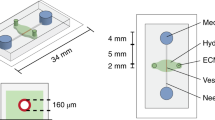Abstract
Investigating the complex cellular interactions of the placenta has remained, until now, a challenge in the field. Given the ethical limitations of studying human placentae, and the interspecies differences that exist between mammals, in vitro models are a valuable tool for investigating developmental and pathologic processes related to the human placenta. A number of in vitro models have been recently employed to investigate various aspects of placental development, with many focusing on the maternal-fetal interface including the trophoblasts and an endothelial barrier. One critical aspect in mimicking the physiology of the placenta is to include perfusable microvessels. As this organ is highly vascularized, it is pertinent to represent the exchange of oxygen and nutrients from the maternal blood to the embedded vessels of the fetus. Using hydrogel-laden microfluidics, it is now possible to bioengineer these and other microvessels in a reproducible manner. By using HUVEC, fetal-like vessels can be generated on a chip and can be studied in a controlled manner. This chapter introduces the concept of generating a triculture vasculature on-chip system, which can be employed to study placental pericyte-endothelial interactions. We describe strategies for generating the vessels on-chip, as well as for quantifying vascular morphology and function. This methodology allows for unique microvessel-related biological questions to be addressed, including how stromal cells impact vascular remodeling over time.
Access this chapter
Tax calculation will be finalised at checkout
Purchases are for personal use only
Similar content being viewed by others
References
Gude NM, Roberts CT, Kalionis B, King RG (2004) Growth and function of the normal human placenta. Thromb Res 114(5–6):397–407. https://doi.org/10.1016/j.thromres.2004.06.038
Griffiths SK, Campbell JP (2014) Placental structure, function and drug transfer. Cont Educ Anaesth Crit Care Pain 15(2):84–89. https://doi.org/10.1093/bjaceaccp/mku013
Kaufmann P, Luckhardt M, Leiser R (1988) Three-dimensional representation of the fetal vessel system in the human placenta. In: Kaufmann P, Miller RK (eds) Placental vascularization and blood flow: basic research and clinical applications. Springer, Boston, pp 113–137. https://doi.org/10.1007/978-1-4615-8109-3_9
Abbas Y, Turco MY, Burton GJ, Moffett A (2020) Investigation of human trophoblast invasion in vitro. Hum Reprod Update 26(4):501–513. https://doi.org/10.1093/humupd/dmaa017
Aengenheister L, Keevend K, Muoth C, Schönenberger R, Diener L, Wick P, Buerki-Thurnherr T (2018) An advanced human in vitro co-culture model for translocation studies across the placental barrier. Sci Rep 8(1):5388. https://doi.org/10.1038/s41598-018-23410-6
Nishiguchi A, Gilmore C, Sood A, Matsusaki M, Collett G, Tannetta D, Sargent IL, McGarvey J, Halemani ND, Hanley J, Day F, Grant S, Murdoch-Davis C, Kemp H, Verkade P, Aplin JD, Akashi M, Case CP (2019) In vitro placenta barrier model using primary human trophoblasts, underlying connective tissue and vascular endothelium. Biomaterials 192:140–148. https://doi.org/10.1016/j.biomaterials.2018.08.025
Chaddha V, Viero S, Huppertz B, Kingdom J (2004) Developmental biology of the placenta and the origins of placental insufficiency. Semin Fetal Neonatal Med 9(5):357–369. https://doi.org/10.1016/j.siny.2004.03.006
Brosens I, Pijnenborg R, Vercruysse L, Romero R (2011) The “Great Obstetrical Syndromes” are associated with disorders of deep placentation. Am J Obstet Gynecol 204(3):193–201. https://doi.org/10.1016/j.ajog.2010.08.009
Miller RK, Genbacev O, Turner MA, Aplin JD, Caniggia I, Huppertz B (2005) Human placental explants in culture: approaches and assessments. Placenta 26(6):439–448. https://doi.org/10.1016/j.placenta.2004.10.002
Soleymanlou N, Jurisica I, Nevo O, Ietta F, Zhang X, Zamudio S, Post M, Caniggia I (2005) Molecular evidence of placental hypoxia in preeclampsia. J Clin Endocrinol Metab 90(7):4299–4308. https://doi.org/10.1210/jc.2005-0078
Higgins LE, Rey de Castro N, Addo N, Wareing M, Greenwood SL, Jones RL, Sibley CP, Johnstone ED, Heazell AE (2015) Placental features of late-onset adverse pregnancy outcome. PLoS One 10(6):e0129117. https://doi.org/10.1371/journal.pone.0129117
Visiedo F, Bugatto F, Quintero-Prado R, Cózar-Castellano I, Bartha JL, Perdomo G (2015) Glucose and fatty acid metabolism in placental explants from pregnancies complicated with gestational diabetes mellitus. Reprod Sci 22(7):798–801. https://doi.org/10.1177/1933719114561558
Carter AM (2007) Animal models of human placentation--a review. Placenta 28(Suppl A):S41–S47. https://doi.org/10.1016/j.placenta.2006.11.002
Grigsby PL (2016) Animal models to study placental development and function throughout normal and dysfunctional human pregnancy. Semin Reprod Med 34(1):11–16. https://doi.org/10.1055/s-0035-1570031
Schmidt A, Morales-Prieto DM, Pastuschek J, Fröhlich K, Markert UR (2015) Only humans have human placentas: molecular differences between mice and humans. J Reprod Immunol 108:65–71. https://doi.org/10.1016/j.jri.2015.03.001
Walker N, Filis P, Soffientini U, Bellingham M, O’Shaughnessy PJ, Fowler PA (2017) Placental transporter localization and expression in the human: the importance of species, sex, and gestational age differences†. Biol Reprod 96(4):733–742. https://doi.org/10.1093/biolre/iox012
Myren M, Mose T, Mathiesen L, Knudsen LE (2007) The human placenta--an alternative for studying foetal exposure. Toxicol in Vitro 21(7):1332–1340. https://doi.org/10.1016/j.tiv.2007.05.011
Cherubini M, Erickson S, Haase K (2021) Modelling the human placental interface in vitro-a review. Micromachines (Basel) 12(8). https://doi.org/10.3390/mi12080884
Haase K, Gillrie MR, Hajal C, Kamm RD (2019) Pericytes contribute to dysfunction in a human 3D model of placental microvasculature through VEGF-Ang-Tie2 signaling. Adv Sci 6(23):1900878. https://doi.org/10.1002/advs.201900878
Haase K, Piatti F, Marcano M, Shin Y, Visone R, Redaelli A, Rasponi M, Kamm RD (2021) Physiologic flow-conditioning limits vascular dysfunction in engineered human capillaries. Biomaterials:121248. https://doi.org/10.1016/j.biomaterials.2021.121248
Author information
Authors and Affiliations
Corresponding author
Editor information
Editors and Affiliations
1 Electronic Supplimentary Material
Rights and permissions
Copyright information
© 2023 The Author(s), under exclusive license to Springer Science+Business Media, LLC, part of Springer Nature
About this protocol
Cite this protocol
Cherubini, M., Haase, K. (2023). A Bioengineered Model for Studying Vascular-Pericyte Interactions of the Placenta. In: Margadant, C. (eds) Cell Migration in Three Dimensions. Methods in Molecular Biology, vol 2608. Humana, New York, NY. https://doi.org/10.1007/978-1-0716-2887-4_23
Download citation
DOI: https://doi.org/10.1007/978-1-0716-2887-4_23
Published:
Publisher Name: Humana, New York, NY
Print ISBN: 978-1-0716-2886-7
Online ISBN: 978-1-0716-2887-4
eBook Packages: Springer Protocols




